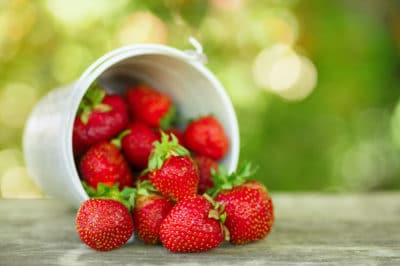A Bit of Physiology
Fruits (and many vegetables) are either climacteric or non-climacteric. Climacteric fruit will continue to ripen after they are picked. Think of bananas, avocados or pears, for example. Others, like strawberries, are non-climacteric. They will not ripen any further. They may lose water and shrink, which makes them taste a little sweeter, but they are not ripe, and yellow or white berries won’t turn red.
Growing Strawberries
If you want your strawberries to ripen reliably, pay attention to growing them properly. They like a loamy, rich soil, slightly on the acid side, that drains well. They need regular water but the soil should not be soggy. Plant them in full sun, or at least give them eight hours of sunlight a day. Fertilize regularly but go easy on nitrogen; it pushes leaf growth, not berries.
Strawberry Types
All strawberries fall into one of three categories, which affects when they bloom and fruit. These are
- June bearers – these have a single large flush of fruit in early summer.
- Everbearers – this type produces fruit in early summer and early fall.
- Day neutral – these are temperature-dependent and will bloom and fruit as long as the temperature is between 35 and 85°F (2 and 29°C).
Strawberry Season
The classic strawberry season is late spring to early summer. Although strawberries can be grown in USDA Zones 3 through 11, they will produce fruit earlier in warmer areas. Everbearers will produce two crops, but the berries are smaller and there are fewer than June bearers. The general rule of thumb is that berries will be ready about four weeks after the plants first bloom.
Color and Ripeness
Color is key to ripeness. If a strawberry is not red all the way through, it isn’t ripe. A berry that has any yellow, white or green is not ripe and should not be picked. Check back a day later, as the fruits can ripen quickly. With the white varieties, a ripe berry will change from pale green or greenish-yellow to cream or ivory.
Other Signs of Ripeness
Ripe strawberries have a luscious, unique scent. Once you’ve smelled it, you will never be fooled by a red but unripe berry. However, some varieties, even when they are fully ripe, just don’t taste very good. They won’t have the same scent, either. A berry that is ripe easily falls into your hand when you pull it slightly. Use those immediately as they won’t keep without the stem and cap.
